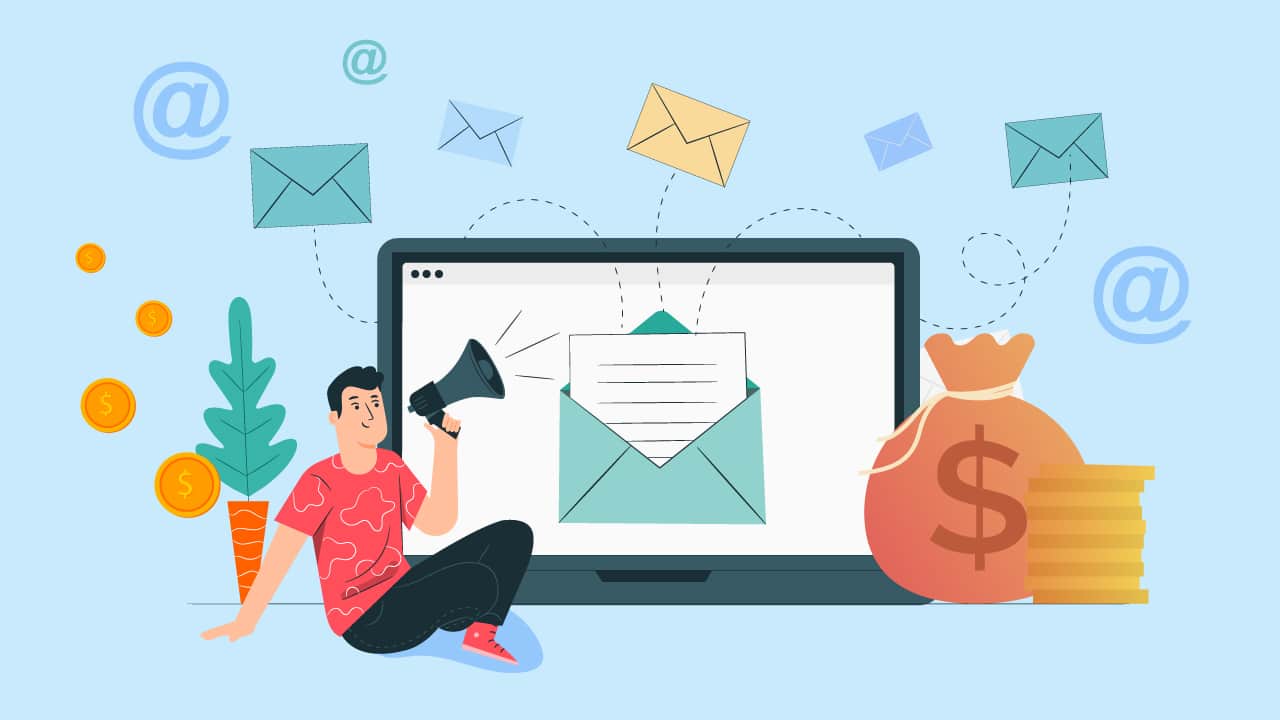
In today’s digital age, sending emails has become integral to our personal and professional communication. It has revolutionized how we connect with others, allowing us to share information and ideas across vast distances with just a few clicks. Whether it’s a quick note to a friend or a formal business proposal, email has become a preferred method of communication for billions of people worldwide.
Have you ever considered the cost of sending an email? With its seemingly instantaneous delivery and low barriers to entry, it’s easy to assume that sending an email is virtually free. But is that really the case?
In this article, we will explore the email cost and the various factors that contribute to the cost of sending an email, providing insights into the hidden expenses that go beyond the surface.
Costs Associated with Sending Emails

1. Infrastructure and Internet Service Providers (ISPs)
Behind every email sent, a vast network of infrastructure and service providers exists. These networks include servers, routers, and data centers that enable the transmission of email data. ISPs play a crucial role in this process by providing internet connectivity to users. They maintain the necessary hardware and software infrastructure to facilitate the transfer of emails from the sender to the recipient. ISPs often charge users a monthly fee for internet access, indirectly contributing to the cost of any email marketing campaign.
The infrastructure required for email transmission includes servers that handle email sending and receiving. The email service provider typically maintains and operates these servers. The cost of maintaining and upgrading servers and the associated energy costs are part of the expenses involved in sending emails.
Internet Service Providers (ISPs) are responsible for routing email traffic. They invest in high-speed connections and network infrastructure to ensure efficient email transmission. ISPs charge users for internet access, and some of these fees contribute to the overall email marketing costs.
2. Data Storage and Maintenance
Emails are not simply transferred from one point to another; they also require storage and maintenance. Email marketing platforms allocate storage space on their servers to house user emails. This storage incurs costs in terms of hardware, electricity, and maintenance. Additionally, service providers must implement security measures to protect email data from unauthorized access or loss, contributing to the overall cost of email transmission.
Email data storage costs are determined by the number of emails saved and the time they must be kept. Email marketing services must invest in data centers, servers, and backup systems to handle the storage requirements of their users. These costs include hardware acquisition, maintenance, cooling systems, and energy consumption.
Maintenance is essential to ensure the reliability and availability of email services. It entails frequent upgrades, backups, and system monitoring to detect and resolve emerging problems. Service providers employ IT professionals to manage and maintain the email infrastructure, adding to the overall cost.
3. Bandwidth Consumption
Sending an email involves transferring data across the internet, which consumes bandwidth. Bandwidth refers to the capacity of an internet connection to transmit data within a given time frame. Service providers often limit users’ bandwidth consumption, mainly residential or mobile internet connections. When an email is sent, it consumes a portion of the allocated bandwidth, which adds to the cost of sending that email. While the cost per email is minimal, the cumulative impact becomes significant when multiplied by the sheer number of messages in email marketing campaigns.
Service providers invest in high-speed internet connections to accommodate the growing demand for email transmission. The bandwidth cost is typically included in the overall pricing structure of internet service plans. Higher bandwidth capacities mean a higher email marketing cost and service providers allocate these expenses to cover the transmission of emails and other data-intensive activities.
4. Spam Filtering and Security
One of the ongoing challenges associated with email communication is spam. Spam refers to unsolicited and often malicious or irrelevant emails that clog up users’ inboxes. Service providers invest in sophisticated filtering mechanisms that identify and block such messages to combat spam. These filters require constant updates and maintenance to ensure their effectiveness. Moreover, developers of email marketing software must invest in robust security measures to protect against hacking attempts and data breaches. These efforts to maintain a secure email environment add to the overall cost of your email marketing strategy.
Spam filtering systems use content analysis, blacklisting, and artificial intelligence algorithms, to identify and filter out spam emails. The development and maintenance of these systems incur costs, including software licensing fees, infrastructure upgrades, and human resources for ongoing monitoring and optimization.
To secure sensitive data, email security methods include deploying encryption, firewalls, intrusion detection systems, and other technology. Regular security audits and upgrades are necessary to stay ahead of evolving cyber threats. These security investments contribute to the overall cost of your email campaign.
5. Service Provider Fees

While individual users may not directly pay for sending emails, many large and small businesses rely on a third-party email marketing platform. These providers offer additional features and services, such as enhanced security, analytics, and customer support. In return, they charge subscription fees based on the required email volume or specific features. The price of these services ranges depending on the supplier and the customization desired by the user.
Email marketing tools offer various plans tailored to different user needs. These plans may include storage capacities, advanced security features, collaborative tools, and technical support. The price of these plans typically depends on the number of users, the number of emails sent, and the necessary additional services.
For businesses, email service providers offer enterprise-level solutions that cater to larger-scale email operations. These solutions often include additional services like integration with customer relationship management (CRM) systems, advanced analytics, and customized branding. The fees for these services are typically negotiated based on the business’s specific requirements.
6. Email Size and Attachments
The size of an email and the presence of attachments can significantly impact the transmission cost. More significant emails consume more bandwidth, take longer to transmit, and require additional storage space. This increased data transfer can increase costs, especially for users with limited bandwidth or data usage plans.
Attachments such as images, videos, or documents contribute to the email size and can further inflate the transmission cost. Subsequently, it is essential to think about the size and need of attachments when sending emails because they might affect the email marketing budget.
How Much Does it Cost to Send an Email: Break Down in Figures

As stated above, determining the exact cost of sending an email can be challenging due to the various factors and the wide range of pricing models employed by different service providers. Additionally, costs may vary depending on the specific circumstances of the sender, such as whether you are sending bulk emails, the size of attachments, and the geographical location.
However, let’s explore general cost figures associated with different email-sending aspects.
1. Infrastructure and Internet Service Providers (ISPs):
- ISPs typically charge users a monthly fee for internet access, indirectly contributing to the cost of sending emails. Residential internet plans can range from $20 to $70 monthly, depending on the speed and data allowance.
- Dedicated business internet services for enterprises can range between $100 and $500 monthly, depending on the size of the company and the necessary capacity.
2. Data Storage and Maintenance:
- Service providers allocate storage space on their servers to store user emails. The storage cost might vary based on the supplier and the amount of storage requested.
- On average, cloud storage services charge around $0.01 to $0.03 per gigabyte monthly. For example, storing 1,000 emails with an average size of 100KB would cost approximately $0.01 to $0.03 monthly.
3. Bandwidth Consumption:
- Residential internet plans often have data caps or limits on bandwidth consumption. There may be extra fees or slower internet speeds if these limitations are exceeded.
- Additional data usage beyond the allocated limits can cost around $10 to $15 per gigabyte, depending on the internet service provider.
4. Spam Filtering and Security:
- Service providers invest in sophisticated spam filtering mechanisms and security measures to protect email users. These costs are usually incorporated into the overall service fees.
- Premium email service providers can charge anywhere from $5 to $30 per user per month, depending on the level of security and filtering features offered.
5. Service Provider Fees:
- Businesses that rely on a third-party email marketing agency may incur costs based on the volume of emails sent or the specific features required.
- Email marketing platforms may charge based on the number of subscribers or the monthly email volume. Costs can range from $10 to $500 per month, depending on the provider and the scale of the email campaigns.
It’s important to note that the figures mentioned above are general estimates, and actual costs may vary significantly based on individual circumstances and service providers. Additionally, these figures do not include factors such as international email transmission costs, compliance with regulatory requirements, or premium service features, which can add to the overall email cost.
While sending an individual email may have minimal cost, businesses and organizations that rely heavily on email communication or require additional features may incur more substantial expenses.
Free Email vs. Paid Email

Regarding email services, users can choose between free email and paid email solutions. Let’s evaluate the two alternatives so you can comprehend their differences and make an educated decision:
Free Email:
- Cost: As the name suggests, free email services do not require any payment. Users can sign up and use the email service without incurring direct financial costs. Some of the free email services include Gmail, Outlook.com, Yahoo Mail, and iCloud Mail server.
- Features and Storage: Free email services typically provide essential features such as email composition, sending and receiving messages, and organization tools like folders and search functions. However, the storage space provided by free email accounts is often limited.
- Advertisements: Free email services are often ad-supported. Advertisements are displayed within the email interface, which can sometimes be intrusive or distracting for users. These ads are usually targeted based on user data and email content.
- Custom Domain: Most free email providers do not allow you to utilize a custom domain for email addresses. Users are restricted to using the email service’s domain, such as @gmail.com or @yahoo.com.
- Support: Support services for free email accounts may be limited or non-existent. Users may have to rely on online resources, forums, or community support for assistance.
Paid Email:
- Cost: Paid email services require a subscription fee, typically monthly or annual. The email cost varies based on the provider and the package chosen. Some of the paid email services include Google Workspace, Zoho Workplace, and Fastmail.
- Features and Storage: Paid email services often offer more advanced features and a higher storage capacity than free email accounts. These features may include enhanced security, advanced organization tools, collaboration features, and integration with other productivity tools.
- Ad-Free Experience: Paid email services generally do not display advertisements, offering users an ad-free experience.
- Custom Domain: Paid email services typically allow using a custom domain for email addresses. This allows businesses and professionals to have email addresses that reflect their domain, giving them a more professional appearance.
- Support: Paid email services usually offer dedicated customer support, including email, live chat, or phone assistance. This ensures that users can receive timely and personalized support when needed.
- Enhanced Security: Paid email services often prioritize security measures such as encryption, spam filtering, and virus scanning to protect user data and prevent unauthorized access.
Choosing between free and paid email depends on individual needs and preferences. Free email services can be suitable for personal use or individuals with basic email requirements. On the other hand, paid email services are ideal for businesses, professionals, or users who require advanced features, customization options, increased storage, and a higher level of support and security.
Conclusion

Finally, depending on the email provider you choose and how many emails you send, the cost of sending one email can range from free to several hundred dollars per user.
If you are simply sending a few emails each day, a free email provider like Gmail or Yahoo may suffice. If your company or organization needs a more sophisticated email service, you might consider employing a professional email service or an email marketing provider. Whatever your demands may be, make sure to do your homework on the many possibilities available for you and pick the one that suits your needs and your budget.
